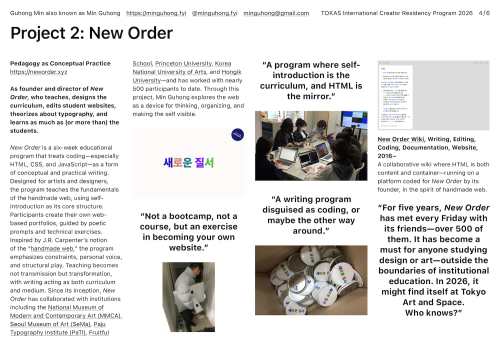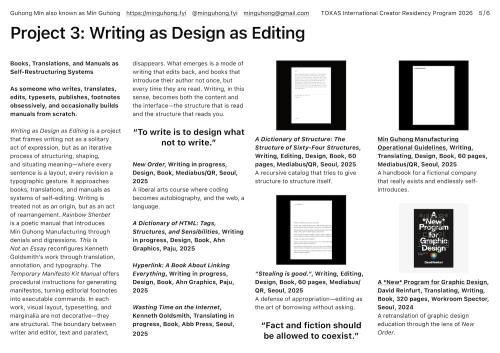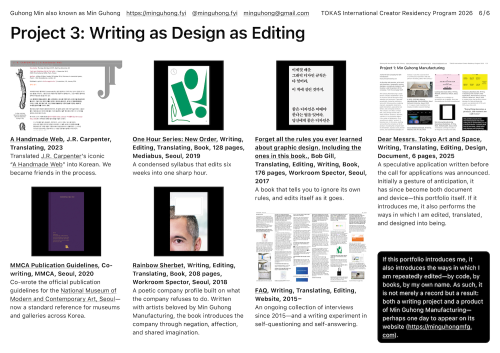Min Guhong suddenly decided to apply for the 2026 International Creator Residency Program organized by Tokyo Arts & Space (TOKAS). Starting in May 2026, this program offers the opportunity to live and work in Tokyo for three months. Most importantly, airfare, accommodation, and production costs are fully covered. Rumored to have been Japanese in a past life, Min saw it as a golden chance to freeload for free in his hometown for three months. Three documents were required for application: the application form, letters of recommendation, and a portfolio. Notably, the portfolio had to present three projects within just six A4 pages.
First, Min prepared his application form. He answered four questions in depth, as if briefly becoming an artist.
1. Define your practice, approach, or artistic interest using four keywords.
- Self-Introduction / Identity: The act of speaking, writing, and revising oneself. At Min Guhong Manufacturing this entire process is done under the guise of a “company introduction.” Self-introduction never ends—it repeats through manuals, websites, products, and texts. Introduction is a mode of being.
- Handmade Web Pedagogy / Learning: Learning HTML, CSS, and JavaScript not just as skills but as sensibilities and attitudes. In New Order, these languages are used to learn how to introduce oneself. Rooted in the spirit of the slow, small web, the web becomes not just a screen but the structure of life.
- Editorial Structures / Form and Content: Writing, refining, and arranging sentences. Manuals that read like poetry, introductions that double as unqualified declarations. At Min Guhong Manufacturing, every document and webpage is an experiment in structural editing. Content cannot exist without form, and form continually rewrites content.
- Parasitic Practice / Method and Technology: A way of staying instead of being independent. Borrowing from the host’s resources and in return offering something. Through writing, web, and design, this company always parasitizes somewhere, and through this parasitism explores new tools and methods.
2. Describe your artistic concept in relation to your past or ongoing projects (within 150 words).
My world unfolds around writing as self-introduction—structured and poetic writing. Through Min Guhong Manufacturing, a one-person company that is both fictional and real, I create manuals, websites, and conceptual documents that function as self-portraits. These simulate micro-infrastructure and explore how identity can be written, edited, and performed. Since 2016, I have run New Order, an experimental class beyond formal education, engaging over 500 participants in using HTML, CSS, and JavaScript as tools for thought and self-formation. I weave publishing, design, and education into a single flow, treating code, typography, and editorial structures not merely as media but as modes of living. This work acts as a design practice in which self-introduction repeats itself, and through language, interface, and repetition, the artist’s existence is continually re-sculpted.
3. Explain why you want to work at TOKAS in Tokyo and what you expect from it (within 150 words).
I have long admired Tokyo’s small-scale publishing cultures, fictional infrastructures, and poetic systems—from doujin software markets to micro-labels and stationery aesthetics. To me, TOKAS is not just a space but a conceptual host for these experimental structures. I want to graft my practice—Min Guhong Manufacturing, a parasitic one-person company—into Tokyo’s layered creative ecology. Through field research, infrastructural mimicry, and quiet observation, I hope to deepen my understanding of self-institution. I’m attracted to Tokyo’s unique blend of rigor and play, where rules are rewritten through forms, formats, and fictions. I hope TOKAS serves not only as a production site but as a rehearsal interface—a corporate-like self, repeatedly reconfigured through others.
4. Describe the purpose and plan of your residency (within 200 words).
Artist Simulator is a parasitic proposal exploring how an artist might exist not within space, but through others. If selected, Min Guhong Manufacturing—a one-person company performing identity through writing, websites, and conceptual output—will temporarily parasitize TOKAS. Over three months, I will develop three editorial tools:
- An interactive manual for self-introduction
- A poetic script for self-performance
- A field guide to artistic parasitism
This project merges ten years of Min Guhong Manufacturing with five years of New Order. New Order is an educational program teaching coding as conceptual writing, where writing, design, and editing are all acts of self-introduction. Artist Simulator tests the hypothesis that artistic identity is not fixed, but rehearsed and reassembled. The artist is not merely presented but rewritten; the author is not an origin but an arrangement, not a declaration, but a device.
After preparing these, Min politely emailed his respected mentors in the art and design world—some of whom were Japanese—to ask for letters of recommendation, hoping that some might happen to know or reach TOKAS’s selection committee:
Dear Professor [Name],
I hope you’re well. I’m writing because I’ve decided to apply for the 2026 International Creator Residency at Tokyo Arts & Space (TOKAS), and would like to humbly ask if you could provide a letter of recommendation.
This program supports visual artists, designers, architects, and filmmakers from around the world, offering a three-month residency in Tokyo for creation and research. I intend to take this chance to freeload in Tokyo while exploring conceptual publishing across writing, coding, and online/offline formats.
Recommendation details:
— Language: English or Japanese
— Format: A4 PDF, dated and signed (hand or digital), free format, no length limit
— Submission: You do not need to send it directly; I will collect and submit it
— Deadline: June 25, 2025, 6 PM JST. Ideally, I could receive it by June 23
I can provide project descriptions, CV, a draft letter, etc., if helpful.
I apologize for the inconvenience during your busy schedule and would be truly grateful for your support.
Sincerely,
Min GuhongLastly, the portfolio. He had to fit three projects within six A4 pages. Reviewing ten years of work, he found it overwhelmingly numerous and chaotic. It was difficult to narrow it down to three strands. So, like a crow soaring through the sky, he widened his gaze and grouped them into three: Min Guhong Manufacturing, New Order, Editing, Design, Writing. This, he hoped, would weave all projects into a single orbit.
The deadline was June 25 at 6 PM. Afterwards, it leaves Min’s hands. Regardless of selection, the application process itself becomes a product of Min Guhong Manufacturing. For some “clients,” it may serve as a cautionary example: “If you prepare your residency application like this, you’re in trouble.” A failed case that is also a self‑introduction.





